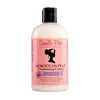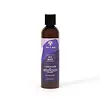What's inside
What's inside
 Key Ingredients
Key Ingredients

No key ingredients
 Benefits
Benefits

 Concerns
Concerns

 Ingredients Side-by-side
Ingredients Side-by-side

Water
Skin ConditioningOpuntia Ficus-Indica Seed Oil
EmollientPrunus Armeniaca Kernel Oil
MaskingUrtica Dioica Extract
AstringentCocos Nucifera Oil
MaskingAloe Barbadensis Leaf Juice
Skin ConditioningSimmondsia Chinensis Seed Oil
EmollientGlycerin
HumectantCetearyl Alcohol
EmollientRosa Canina Fruit Oil
EmollientEquisetum Arvense Extract
AstringentBehentrimonium Methosulfate
Olus Oil
EmollientAlmondeth-20
EmulsifyingTheobroma Cacao Seed Butter
EmollientPhenoxyethanol
PreservativeCitric Acid
BufferingWater, Opuntia Ficus-Indica Seed Oil, Prunus Armeniaca Kernel Oil, Urtica Dioica Extract, Cocos Nucifera Oil, Aloe Barbadensis Leaf Juice, Simmondsia Chinensis Seed Oil, Glycerin, Cetearyl Alcohol, Rosa Canina Fruit Oil, Equisetum Arvense Extract, Behentrimonium Methosulfate, Olus Oil, Almondeth-20, Theobroma Cacao Seed Butter, Phenoxyethanol, Citric Acid
Water
Skin ConditioningGlycerin
HumectantBetaine
HumectantCetearyl Alcohol
EmollientCetyl Alcohol
EmollientLinum Usitatissimum Seed Extract
PerfumingBrassicamidopropyl Dimethylamine
Skin ConditioningPolyglyceryl-3 Betainate Acetate
Oryza Sativa Extract
AbsorbentBiotin
AntiseborrhoeicCeramide NP
Skin ConditioningPhytosterols
Skin ConditioningInositol
HumectantCopper Tripeptide-1
Skin ConditioningSerenoa Serrulata Fruit Extract
Skin ConditioningCocos Nucifera Oil
MaskingCetyl Esters
EmollientC12-15 Alkyl Lactate
EmollientLactic Acid
BufferingLauramidopropyl Hydroxysultaine
CleansingCaprylhydroxamic Acid
Sodium Chloride
MaskingCaprylyl Glycol
EmollientPotassium Sorbate
PreservativeSodium Benzoate
MaskingWater, Glycerin, Betaine, Cetearyl Alcohol, Cetyl Alcohol, Linum Usitatissimum Seed Extract, Brassicamidopropyl Dimethylamine, Polyglyceryl-3 Betainate Acetate, Oryza Sativa Extract, Biotin, Ceramide NP, Phytosterols, Inositol, Copper Tripeptide-1, Serenoa Serrulata Fruit Extract, Cocos Nucifera Oil, Cetyl Esters, C12-15 Alkyl Lactate, Lactic Acid, Lauramidopropyl Hydroxysultaine, Caprylhydroxamic Acid, Sodium Chloride, Caprylyl Glycol, Potassium Sorbate, Sodium Benzoate
Ingredients Explained
These ingredients are found in both products.
Ingredients higher up in an ingredient list are typically present in a larger amount.
Cetearyl alcohol is a mixture of two fatty alcohols: cetyl alcohol and stearyl alcohol. It is mainly used as an emulsifier. Emulsifiers help prevent the separation of oils and products. Due to its composition, it can also be used to thicken a product or help create foam.
Cetearyl alcohol is an emollient. Emollients help soothe and hydrate the skin by trapping moisture.
Studies show Cetearyl alcohol is non-toxic and non-irritating. The FDA allows products labeled "alcohol-free" to have fatty alcohols.
This ingredient is usually derived from plant oils such as palm, vegetable, or coconut oils. There is debate on whether this ingredient will cause acne.
Due to the fatty acid base, this ingredient may not be Malassezia folliculitis safe.
Learn more about Cetearyl AlcoholCocos Nucifera Oil is obtained from the kernels of the coconut fruit. In other words, this is coconut oil.
Coconut Oil is rich in fatty acids with lauric acid making up the majority of these. It also contains linoleic acid. Due to this high fatty acid content, coconut oil helps trap moisture and soften skin.
Despite being antibacterial, coconut oil may not be great for acne-prone skin. It is comedogenic and may clog pores. This ingredient may not be safe for malassezia or fungal acne.
Note: Coconut Oil should not replace your sunscreen for UV protection. Studies show it only blocks about 20% of UV.
This oil is non-volatile and has a light scent.
The term 'fragrance' is not regulated in many countries. In many cases, it is up to the brand to define this term. For instance, many brands choose to label themselves as "fragrance-free" because they are not using synthetic fragrances. However, their products may still contain ingredients such as essential oils that are considered a fragrance.
Learn more about Cocos Nucifera OilGlycerin is already naturally found in your skin. It helps moisturize and protect your skin.
A study from 2016 found glycerin to be more effective as a humectant than AHAs and hyaluronic acid.
As a humectant, it helps the skin stay hydrated by pulling moisture to your skin. The low molecular weight of glycerin allows it to pull moisture into the deeper layers of your skin.
Hydrated skin improves your skin barrier; Your skin barrier helps protect against irritants and bacteria.
Glycerin has also been found to have antimicrobial and antiviral properties. Due to these properties, glycerin is often used in wound and burn treatments.
In cosmetics, glycerin is usually derived from plants such as soybean or palm. However, it can also be sourced from animals, such as tallow or animal fat.
This ingredient is organic, colorless, odorless, and non-toxic.
Glycerin is the name for this ingredient in American English. British English uses Glycerol/Glycerine.
Learn more about GlycerinWater. It's the most common cosmetic ingredient of all. You'll usually see it at the top of ingredient lists, meaning that it makes up the largest part of the product.
So why is it so popular? Water most often acts as a solvent - this means that it helps dissolve other ingredients into the formulation.
You'll also recognize water as that liquid we all need to stay alive. If you see this, drink a glass of water. Stay hydrated!
Learn more about Water